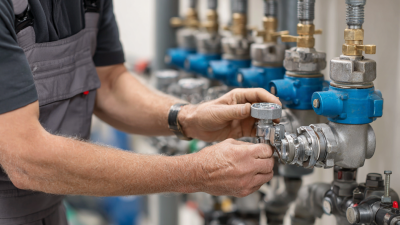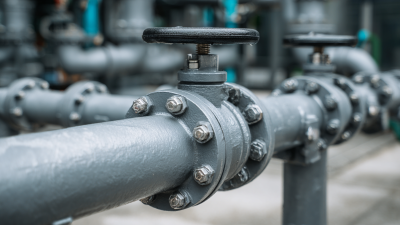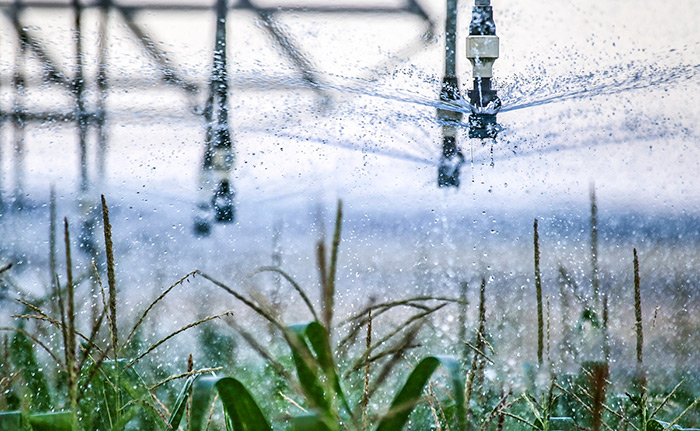Mastering Fluid Control with Reliable 2 Inch PVC Valves: Your Ultimate Guide
Table of Contents
- Understanding the Different Types of 2 Inch PVC Valves for Fluid Control
- Key Features and Benefits of Reliable 2 Inch PVC Valves
- Installation and Maintenance Tips for Optimal Performance of PVC Valves
- Common Applications of 2 Inch PVC Valves in Various Industries
- Troubleshooting and Solving Common Issues with PVC Valves
- Comparing PVC Valves with Other Valve Materials for Fluid Management
- Innovative Plumbing Solutions: Exploring CPVC Ball Valves for Efficient Water Supply Systems
- FAQS
- Conclusion
- Related Posts
When it comes to controlling fluids, really getting a grasp on using dependable components can make all the difference in getting things to run smoothly. This guide walks you through the key points of working with 2 Inch PVC Valves — why they’re so important across different setups. As a team with over 10 years of experience exporting plastic pipes, fittings, and valves, Ningbo Pntek has been helping customers find the right solutions. Whether you're looking to upgrade your plumbing or improve your farming irrigation systems, we’ve got the know-how to steer you in the right direction. So, let’s dive into the world of 2 Inch PVC Valves together—covering their features, some quick tips on installation, and maintenance tricks that’ll keep everything flowing just right. We're here to help you keep your fluid management seamless and hassle-free.

Understanding the Different Types of 2 Inch PVC Valves for Fluid Control
When you're dealing with fluid control, it's really important to get a good handle on the different types of 2-inch PVC valves out there. These little guys are pretty much the backbone when it comes to managing and directing liquids—whether you’re working at home or running a big industrial setup. You’ll find all sorts—ball valves, gate valves, check valves—and each one has its own perks depending on what you need. For example, ball valves are tough and give you a really tight seal, while gate valves are great if you're aiming for minimal pressure loss.
A quick tip: when you're picking out a 2-inch PVC valve, think about things like the pressure they can handle, whether they're compatible with your type of fluid, and how easy they are to install. Also, don’t forget to consider the environment where they'll be used—this can really affect how long they last and how well they perform.
Here at Ningbo Pntek Technology Co., Ltd., we’re proud to be a trusted supplier of plastic pipes, fittings, and valves—with over ten years of experience exporting worldwide. Our wide selection of 2-inch PVC valves is made to cover different fluid control needs, so you can count on their performance no matter where you use them. When shopping around, make sure to go for quality—check certifications and reviews so you’re getting stuff that’s built to last.
Key Features and Benefits of Reliable 2 Inch PVC Valves
Reliable 2-inch PVC valves are pretty much essential when you're dealing with fluid control systems. They’re known for being durable, efficient, and pretty easy to work with. One of the coolest things about these valves is their resistance to corrosion. That makes them perfect for all sorts of uses, like chemical processing or water treatment—things where metal valves might struggle with rust. Unlike metal ones, PVC valves don’t rust or corrode, which means they last longer and save you money on maintenance. Plus, they’re lightweight, so installing and handling them isn’t a hassle—making it easier to fit them into your existing piping setup without breaking a sweat.
And let’s not forget how flexible they are. You can find these 2-inch PVC valves in different styles, like ball valves or gate valves, depending on what kind of flow control you need. Their smooth interior surface helps fluids move easily, which cuts down on energy loss and keeps things running smoothly. Many of these valves also come with options for manual or automated control, so you can pick what suits your setup best. All in all, with their solid combo of performance and durability, these PVC valves are a smart pick for anyone serious about controlling fluids in their systems.
Installation and Maintenance Tips for Optimal Performance of PVC Valves
When you're working with 2-inch PVC valves, keeping them in tip-top shape really depends on proper installation and regular maintenance. First off, make sure the area where you're installing the valve is super clean—no dirt or debris floating around, because even tiny particles can mess with the seal and cause leaks. Don't forget to wrap Teflon tape around the threaded connections; it’s a simple trick that helps make everything airtight and prevents leaks down the line. Oh, and when you're tightening those fittings, try to follow the manufacturer’s recommended torque specs—you don’t want to overdo it and end up damaging the valve, right?

Doing routine checks can really extend how long your valves last. Take a moment every now and then to look for any cracks or discoloration—that’s usually a sign something’s wearing out. Flushing the system occasionally to clear out sediment or dirt build-up is also a good move, keeping things flowing smoothly. And if you notice any moving parts sticking, a little bit of the right lubricant can make a world of difference—they’ll operate more smoothly and avoid jamming.
Stick to these simple tips, and your PVC valves should keep performing well over time, giving you reliable fluid control when you need it most.
Common Applications of 2 Inch PVC Valves in Various Industries
You know, 2-inch PVC valves are pretty much everywhere in different industries these days. People love them because they're reliable and don't break the bank. I came across a report from MarketsandMarkets that predicts the global market for these valves could hit around USD 1.2 billion by 2027. That’s mainly because folks are really looking for lightweight, corrosion-resistant materials that can handle tough conditions. You'll see these valves often in farming, especially in irrigation setups, where they do a good job controlling water flow without any fuss. As more farmers push for sustainable methods, having PVC valves that can stand up to harsh chemicals and soil stuff really makes a difference—they help manage resources better and last longer.
In the chemical industry, 2-inch PVC valves are kind of essential too, since they handle all kinds of corrosive chemicals safely. A study from Research and Markets even says the demand for PVC in this field is expected to climb, hitting about 3 million tons by 2025. What’s cool is these valves can be tailored to different pressure levels and flow needs, which makes them super versatile and safe to use. They’re also key in HVAC systems, where they help control airflow and keep things running smoothly. All in all, it’s pretty clear that 2-inch PVC valves are a big deal across the board—they keep fluid moving reliably in all sorts of industrial setups.
Troubleshooting and Solving Common Issues with PVC Valves
Dealing with those 2-inch PVC valves? Yeah, they can be a bit tricky sometimes, and a lot of common issues tend to mess with how well the fluid flows. I read somewhere—actually, a report from the American Society of Plumbing Engineers—that up to 35% of valve problems in PVC setups come down to either poor installation or not enough maintenance. One big headache for folks is leaks—that sneaky stuff often happens because seals are faulty or the connections just aren’t lined up right. Not only does that mess with the whole system, but it can also mean digging into your wallet for repairs and dealing with more downtime, which is such a pain.
Oh, and don’t forget, environmental stuff plays a role too. Exposure to sunlight and UV rays can actually wear down the material over time. I came across a study from the National Institute of Standards and Technology that said PVC valves can lose around 10-20% of their strength after a bunch of UV exposure—that’s pretty serious and can lead to early failures. That’s why checking your valves regularly and sticking to maintenance schedules is such a good idea. It helps keep everything running smoothly and makes those valves last way longer. Once you know the common hiccups, it’s easier to troubleshoot and keep your fluid control system working like a champ.
Comparing PVC Valves with Other Valve Materials for Fluid Management
When it comes to managing fluids effectively, choosing the right valve material really makes a difference. PVC valves are pretty popular these days—people often prefer them for their reliability and efficiency in controlling fluids. They’re lightweight, corrosion-resistant, and easy to install, which makes them great for all kinds of settings—from big industrial plants to homes. On the other hand, metal valves can corrode over time, leading to failures and often more maintenance hassle. Knowing these little differences can really help you pick the perfect valve for what you need.

A few tips? Think about the type of fluid you're dealing with—its temperature, chemical makeup, all that. Also, consider where you’re installing the valve. PVC tends to hold up well even in tough conditions, so it can boost your overall efficiency. Plus, if you're working in sensitive areas, like giving IV fluids to kids, the right valve actually helps ensure the fluid goes exactly where it’s supposed to—making patient care better.
These days, fluid management isn’t just about the hardware; technology plays a big role too. Using smart systems that monitor and optimize fluid flow can really make a difference, especially in medical settings like dialysis or sepsis treatment. By choosing reliable PVC valves and integrating them into these systems, healthcare providers can improve safety, efficiency, and patient outcomes all at once. In the end, smart selection and proper use of these valves don’t just streamline operations—they genuinely help save lives.
Innovative Plumbing Solutions: Exploring CPVC Ball Valves for Efficient Water Supply Systems
In the realm of efficient water supply systems, the adoption of innovative plumbing solutions is critical. One of these solutions is the use of CPVC (Chlorinated Polyvinyl Chloride) ball valves, which are increasingly favored for their durability and resistance to corrosion. A report from the American Society of Plumbing Engineers (ASPE) highlights the growing trend towards CPVC in residential and commercial plumbing applications, citing that this material has a lower thermal conductivity, which contributes to its energy efficiency. By employing CPVC ball valves, systems not only enhance flow control but also reduce the risks associated with leaks and failures typical in traditional metallic setups.
CPVC ball valves are available in various sizes to accommodate diverse plumbing needs, from 1/2 inch to 2 inches. The versatility of these valves allows for seamless integration into existing systems, providing significant advantages in terms of installation and maintenance. For example, a sample of a 1-1/2 inch CPVC valve is available at just $0.10 per piece, presenting cost-effective options for both new installations and retrofitting projects. The lightweight nature of CPVC also simplifies handling during installation, which can shorten project timelines and reduce labor costs, making it an attractive choice for plumbing professionals.
Adopting such innovative products can lead to improved longevity and performance in water supply systems. As the industry moves towards sustainable practices, utilizing CPVC ball valves not only aligns with environmental objectives but also satisfies the increasing demand for reliable and efficient plumbing solutions.
FAQS
: 2-inch PVC valves are widely used in agriculture for irrigation systems, chemical processing for handling corrosive substances, and HVAC systems for managing airflow.
The market is projected to reach USD 1.2 billion by 2027 due to increasing demands for lightweight and corrosion-resistant materials.
Common issues include leakage from faulty seals or misaligned connections, as well as performance degradation due to environmental factors and UV light exposure.
Regular inspection and adherence to recommended maintenance schedules can help ensure optimal performance and extend the lifespan of PVC valves.
PVC valves are corrosion-resistant, lightweight, and easier to install, making them more reliable and cost-effective for various applications compared to metal valves, which may corrode over time.
Users should consider the fluid characteristics (temperature and chemical compatibility) and the installation environment to determine if PVC is the best choice for their needs.
Employing the right PVC valves in sensitive contexts, like pediatric intravenous therapy, contributes to better patient outcomes by ensuring precise control over fluid delivery.
Prolonged UV exposure can lead to a loss of 10-20% of the tensile strength of PVC valves, resulting in premature failure.
PVC valves are essential for effective resource management in agriculture as they withstand harsh chemicals and soil conditions, supporting sustainable practices in irrigation systems.
Modern challenges necessitate an intelligent approach to select valves that can integrate with monitoring technologies to optimize fluid parameters and improve operational efficiency.
Conclusion
The article titled "Mastering Fluid Control with Reliable 2 Inch PVC Valves: Your Ultimate Guide" dives pretty deep into the different types of 2-inch PVC valves out there. It really breaks down what makes each one special and how they can help with managing fluids smoothly. If you’re wondering about setting them up or keeping them in top shape, it’s got you covered with practical tips—so your valves keep working like a charm. Plus, it talks about where you’d typically see these valves in action – across all kinds of industries. Oh, and if you hit a snag, there are troubleshooting tricks to get you back on track. To top it off, it compares PVC valves to other types of valves, giving you a clear picture of why PVC might be the right choice.
On the company side, Ningbo Pntek Technology Co., Ltd. has been around for over ten years, confidently exporting plastic pipes, fittings, and valves—including the trusty 2-inch PVC valve. It’s popular because it’s durable and gets the job done efficiently. This guide isn't just some technical read; it’s a really handy resource for anyone serious about mastering PVC valves and making the most of them in their work.
Related Posts
-

Why Investing in Pvc Valve Socket Ends Can Enhance Your Pipeline Efficiency by 30 Percent
-

How to Choose the Right Pvc Union Valve for Your Industrial Needs Based on Performance Data
-

How to Choose the Right 1 Inch PVC Valves for Your Plumbing Needs
-

7 Essential Tips for Choosing the Best 6 PVC Ball Valves for Your Projects
-

5 Tips for Choosing the Right 2 PVC Valves for Your Project
-

Ultimate Guide to 2 Inch PVC Check Valves: Ensuring Optimal Flow Control and System Efficiency
Blog Tags:

Ethan
Application

Underground pipeline

Irrigation System

Water Supply System


